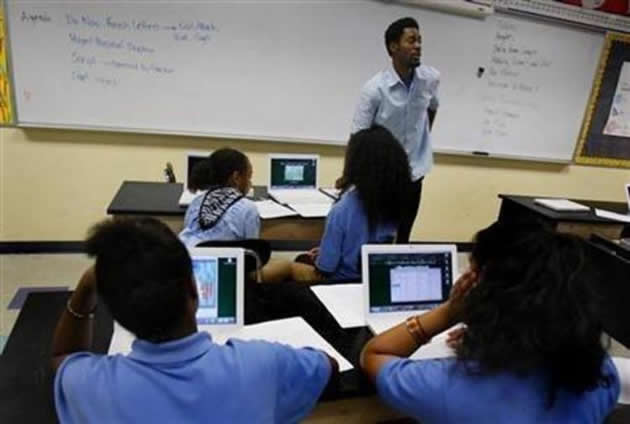Tips on online education

 Choosing the online route
Choosing the online route
There are benefits to choosing an online degree programme. Courses can be cheaper than in-class courses, there is flexibility to take classes day or night, and location won’t hinder your chances to earn the degree. But there are also many factors to consider. Below are some tips that one needs to know when considering online education.
Define your online education goals
Students who decide to go the online route have many reasons for doing so: cost-friendly courses, limited time due to family or work commitments, or a desire for career advancement, among others. Before starting the online programme search, students should define why they want to earn a degree online
Explore accredited programmes
There are many online providers offering courses to willing participants, but not all programmes come with a stamp of approval like accreditation.
Although students may be able to receive a quality education, degrees without reputable accreditation may not be as appealing to grad schools or employers.
Find out how tuition is handled
Many online education programs do not have a universal method of charging students. Before starting a programme, students should find out how tuition is handled – whether it is charged by the credit hour or year, or in one lump sum.
Search for scholarships to fund your education
Just like at traditional higher education programmes, there are financial resources available to help fund an online degree.
Students should contact online providers directly or look for organisations that specifically offer scholarships for online education programs.
See if you can test out of certain online courses
While online education programs may provide a variety of ways to cut costs, students can potentially test out of certain courses through Prior Learning Assessments – and earn credit in areas that they’ve already mastered without going through the classes.
Research the instructors
Although online programmes can save students a lot of money, the investment may go to waste if they have poor instructors.
Students considering online education should try to reach out to educators in the programs and ask questions about how the programs are administered.
Make sure your technology is current
No matter how good an online programme may be, the experience can be hindered if a student is not using technology to support the courses. Students who have slow internet connections or limited access to computers will have problems completing assignments.
Consider must-have tools you’ll need to purchase
Many online and distance-learning students cite a reliable internet connection as the most important – if not the only – thing they need to succeed.
With a dizzying array of new and pricey digital toys being produced regularly, many online students swear by their iPads and iPhones. Others say online education should be user friendly and low tech.
“Any online programme that imposes significant technological requirements upon its students is a programme (that) is poorly conceived and ill designed,” says Harlan Platt, a finance professor and faculty director of Northeastern University’s online M.B.A. programme.
In fact, a handful of online students at University of Massachusetts – Amherst use dial-up connections to log onto their courses, according to Melanie DeSilva, marketing and recruitment manager for the school’s University Without Walls. Most online students fall somewhere between the dial-up users and those who purchase every new gadget and device, so here are four technologies that can work for everyone:
1. A printer: Many online students may think they’ve liberated themselves from hard copies—but some online students still prefer to handle printed materials. Becky DoRan Radvilas, for example, studies at the online school Western Governors University and prints her research papers. When she can’t convert some of the E-books that WGU provides into PDFs to view on her Kindle, she prints those out, too.
Bill Horne, who runs William Warren Consulting, a telecommunications consultancy in Sharon, Mass., and works with online universities, recommends investing in a printer that’s easy to transport to meetings and while traveling.
“(H)aving your own machine will save you the transit time and frustration of waiting until (commercial printers) open and trying to get there before they close,” he says.
2. Tools for easy bibliographies: Like their peers in traditional programs, online students have to write papers, which mean they need to know the proper format for citing the works they reference. EasyBib.com is one product available to help with bibliography formatting. Students paste website addresses and book titles into EasyBib, which automatically formats citations. Students can access the Modern Language Association style for free, or pay a fee to use the American Psychological Association and Chicago styles, company spokesman Kerry Kitka says.
Radvilas, the Western Governors student, pays US$3,99 a month for EasyBib, while Amanda Hoerter, who teaches English at The Alternative High School in Wausau, Wis., used the free version to format the bibliography of her 140-page senior thesis at University of Wisconsin – Stevens Point. Hoerter, who has taught online courses, recommends EasyBib with the caveat that it only capitalises the first word of book titles and can’t interpret Web addresses for PDFs. – usnews.com
Other tools for making bibliographies include BibMe.
3. Note-taking software: Some might assume that online students don’t need to take notes, but many use programs to highlight and comment on lectures and readings. Programs such as Evernote and Microsoft’s OneNote allow users to take, share, and archive notes.The services can act as “information dumps” in which students keep their work organized between classes and semesters, says Henry Imler, a course review specialist at Columbia College’s online campus.
Stacey Acevero, the social media community manager for Vocus’s PRWeb and a master’s student at the University of Phoenix, says she uses both Evernote and OneNote to take notes while she reads her online textbooks.
“[T]hey are fantastic note taking programs that allow for a much more visual approach than just typing a couple of sentences that probably won’t be understood later,” she says.
4. Web cams and headsets: Many online programs rely on Web cameras so students and faculty members can video chat. Tadd Rosenfeld, chief executive officer of Team Launcher, an international outsourcing company, says more than 50 of his employees earned their degrees online. He says USB-based headsets are a “must-have for distance learning if you want to participate effectively in spoken classroom conversation over the Internet.” -usnews.com






Comments